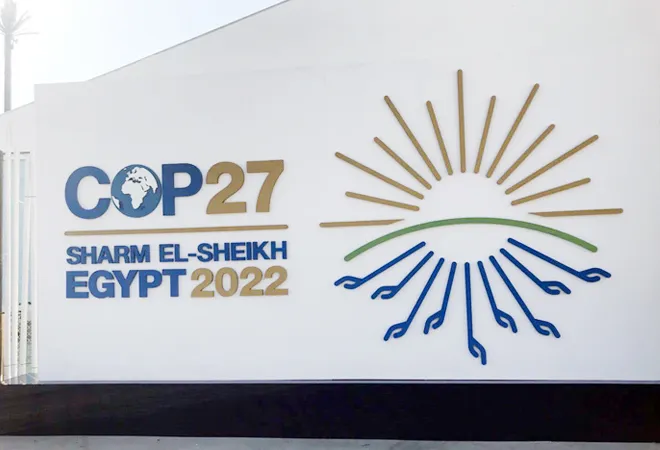-
CENTRES
Progammes & Centres
Location
The COP27 can serve as a platform for India to rally for climate justice and further its climate agenda during its upcoming G20 presidency

This piece is part of the series, Common But Differentiated Responsibility: Finding Direction In COP27
A strong positive correlation exists between the traditional approach to economic growth and development on the one hand, and climate change on the other. This is also evident in the fact that, today, China, the United States (US), European Union (EU), and India are the largest carbon emitters globally. The Group of Twenty (G20) nations account for nearly 75-80 percent of the global greenhouse gas emissions. Nine of the top 10 emitters consist of developed and emerging economies belonging to the G20 grouping. These include the top four emitters mentioned above. The other emitters include Russia, Japan, Brazil, Indonesia, and Canada.
Responsibility for climate action is better allocated based on an appraisal underlined by the CBDR principle since such appraisal takes into account the share in historical emissions.
While India is third among the highest carbon emitting countries in the world, appraising the nation’s performance from the perspective of Common But Differentiated Responsibilities (CBDR) presents a completely different picture. Responsibility for climate action is better allocated based on an appraisal underlined by the CBDR principle since such appraisal takes into account the share in historical emissions; demographic concerns such as population, levels of economic growth and human development; and the financial, technological, and scientific capacity to embrace a green transition.
An upcoming report by the Observer Research Foundation seeks to undertake an assessment of the climate performance of the G20 nations anchored in the CBDR principle. The report develops the Climate Performance Index synthesising the following indicators: Per capita CO2 emissions from fossil fuel combustion, per capita non-carbon GHG emissions, share of global cumulative carbon emissions relative to the share of global cumulative population, energy efficiency of production, renewable energy consumption as a share of total final energy consumption, climate policy coverage, carbon cost of growth, Theil’s index of carbon inequality, rate of per capita energy-use relative to 2000 watts, percentage change in climate-altering land cover, and percentage change in climate regulating land cover.
While CO2 emissions from fossil fuels and industrial processes dominate the composition of GHG emissions, the global warming capacity of non-carbon GHG emissions from sectors such as land use is significantly higher and critically important for countries with a large primary sector. Hence, there is a need to incorporate information on both these emissions into the assessment of climate performance. The principle of climate justice demands that nations be compared in terms of per capita emission levels rather than total emissions. The share of global cumulative carbon emissions relative to the share of global cumulative population provides information about a nation’s contribution to historic emissions relative to the size of the population whose needs were catered to through those emissions. As such, this indicator is a measure of a nation’s long-term contribution to global warming. Progress made in terms of energy efficiency of production and renewable energy consumption as a share of total final consumption catalyses the speed of the green transition. In fact, such transition is a function of optimising energy use and increased adoption of renewables.
The share of global cumulative carbon emissions relative to the share of global cumulative population provides information about a nation’s contribution to historic emissions relative to the size of the population whose needs were catered to through those emissions.
Climate policy coverage assesses whether a specified list of policies exist across six key sectors, namely, agriculture and forestry, land transport, buildings, industry, electricity and heat, and general climate action targeting five mitigation areas: Changes in energy demand and resource use efficiency; energy efficiency; renewables; other low-carbon technologies; and fuel switch non-energy-related emissions.
The carbon cost of growth measures the cost of economic growth in terms of carbon emissions. Decoupling economic growth from carbon emissions has become critical for keeping global warming well below 2 degrees Celsius and for realising the net-zero targets pledged by countries. A negative carbon cost of growth implies absolute decoupling. A positive carbon cost of growth which is less than unity implies relative decoupling. A positive carbon cost of growth greater than unity implies no decoupling.
Theil’s index of carbon inequality is a measure of the within-country inequalities in consumption-based emissions. This index throws light on the inequality in energy access, which tends to mirror income inequality. On the other hand, the rate of per capita energy use relative to 2000 watts measures the excess consumption of energy over the threshold of 2000 watts, which is quite close to the global average. This indicator captures the between-country inequalities in energy access.
Percentage change in the climate regulating land cover measures the change in the land cover which is responsible for regulating the global GHG concentration and the greenhouse effect. Percentage change in the climate-altering land cover measures the change in the land cover which has a negative influence on the biogeochemical processes involved in the global GHG concentration and, thereby, global warming.
The nation comes third among G20 nations in terms of its performance relating to climate policy coverage and climate-altering land cover.
India emerges as the frontrunner among the G20 members in terms of the Climate Performance Index, which captures the above-mentioned indicators. India ranks first among the G20 members in terms of the following indicators: per capita CO2 emissions from fossil fuel combustion, per capita non-carbon GHG emissions, the share of global cumulative carbon emissions relative to the share of the global cumulative population, rate of per capita energy-use relative to 2000 watts, and percentage change in climate regulating land cover. India also ranks second among G20 members in its performance relating to renewable energy consumption as a share of total final energy consumption. The nation comes third among G20 nations in terms of its performance relating to climate policy coverage and climate-altering land cover. However, in terms of the carbon cost of growth, India achieved relative decoupling and is outperformed by other G20 nations which have achieved absolute decoupling. There is also considerable scope for improvement in India’s performance in terms of energy efficiency of production.
The above-mentioned indicators represent different dimensions of climate performance as it relates to the CBDR principle. India’s performance on these different dimensions demarcates what its stance should be in the ongoing COP27 summit. Clearly, India can consider pursuing the different dimensions of the CBDR principle that have yet to be incorporated into the climate dialogue. Firstly, not only has the developed world historically exploited the carbon budget, the current expenditure of the carbon budget is skewed in favour of the developed world. From the perspective of climate justice, it is only fair that a larger portion of the remaining carbon budget be allocated to the developing world given that energy access is critical for development. India can put forth this proposition at the COP27 summit. Assigning a fair allocation of the carbon budget to the developing world involves adjusting the Nationally Determined Contributions (NDCs) to mirror this fair allocation.
The Indian initiative can also serve as an example of how behavioural nudges can make climate action more inclusive and effective.
Secondly, India and the United Nations jointly launched Mission LiFE (Lifestyle for Environment) recently, anchored in SDG 12 i.e., Sustainable Consumption and Production. This aligns with limiting and altogether concluding overconsumption of materials and energy. India can advocate greater support for and adoption of Mission LiFE among other nations at the COP27 summit. Mission LiFE, no doubt, presents an inherent “dichotomy” between the growth prospects and climate performance of consumption-driven economies such as India and many others in the Global South. India will, therefore, have to carefully navigate its priorities to ensure that the initiative is successful and sustainable in the long run. The Indian initiative can also serve as an example of how behavioural nudges can make climate action more inclusive and effective. India can initiate a conversation about how international climate governance needs to contemplate on supporting the development of the institutional, financial, regulatory, and technical ecosystem for implementing Mission LiFE.
Thirdly, climate policies need to take into account their impact on those negatively affected by carbon inequality. In fact, policies which fail to do so may increase the burden of lack of development on the poor sections of the population. Climate action should not be formulated in isolation to poverty alleviation programmes. This perspective of climate policy can be put forth at the COP27 summit.
Lastly, developing countries require support in terms of climate finance, technology transfer, knowledge sharing and exchange of best practices in formulating green growth policies, and thereby reducing the carbon cost of growth. India can throw light on the need for extending such support to developing countries at the COP27 summit.
The COP27 summit is happening just a month prior to India assuming its G20 presidency. In conclusion, India can utilise the COP27 summit to inaugurate its climate agenda and can accelerate efforts to further this agenda at its G20 presidency.
The views expressed above belong to the author(s). ORF research and analyses now available on Telegram! Click here to access our curated content — blogs, longforms and interviews.

Debosmita Sarkar is an Associate Fellow with the SDGs and Inclusive Growth programme at the Centre for New Economic Diplomacy at Observer Research Foundation, India. Her ...
Read More +
Renita DSouza is a PhD in Economics and was a Fellow at Observer Research Foundation Mumbai under the Inclusive Growth and SDGs programme. Her research ...
Read More +